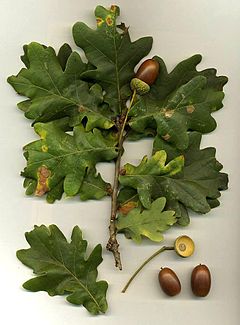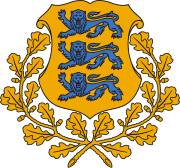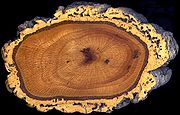Oak
| Oaks | ||||||||||||
|---|---|---|---|---|---|---|---|---|---|---|---|---|
 Foliage and acorns of Quercus robur | ||||||||||||
| Scientific classification | ||||||||||||
| ||||||||||||
| Species |
The term oak can be used as part of the common name of any of several hundred species of trees and shrubs in the genus Quercus (from Latin "oak tree"), which are listed in the List of Quercus species, and some related genera, notably Cyclobalanopsis and Lithocarpus. The genus is native to the northern hemisphere, and includes deciduous and evergreen species extending from cold latitudes to tropical Asia and the Americas.
Oaks have spirally arranged leaves, with a lobed margin in many species; some have serrated leaves or entire leaves with a smooth margin. The flowers are catkins, produced in spring. The fruit is a nut called an acorn, borne in a cup-like structure known as a cupule; each acorn contains one seed (rarely two or three) and takes 6-18 months to mature, depending on species. The "live oaks" (oaks with evergreen leaves) are not a distinct group, instead with their members scattered among the sections below.
Classification
Oak trees are flowering plants. The genus is divided into a number of sections:
- Sect. Quercus (synonyms Lepidobalanus and Leucobalanus), the oaks of Europe, Asia and North America. Styles short; acorns mature in 6 months, sweet or slightly bitter, inside of acorn shell hairless. Leaves mostly lack a bristle on lobe tips, which are usually rounded.
- Sect. Mesobalanus, the Hungarian oak and its relatives of Europe and Asia. Styles long; acorns mature in 6 months, bitter, inside of hairless acorn shell (closely related to sect. Quercus and sometimes included in it).
- Sect. Cerris, the Turkey oak and its relatives of Europe and Asia. Styles long; acorns mature in 18 months, very bitter, inside of acorn shell hairless. Leaves typically have sharp lobe tips, with bristles at the lobe tip.
- Sect. Protobalanus, the Canyon live oak and its relatives, in southwest United States and northwest Mexico. Styles short, acorns mature in 18 months, very bitter, inside of acorn shell woolly. Leaves typically have sharp lobe tips, with bristles at the lobe tip.
- Sect. Lobatae (synonym Erythrobalanus), the red oaks of North America, Central America and northern South America. Styles long, acorns mature in 18 months, very bitter, inside of acorn shell woolly. Leaves typically have sharp lobe tips, with spiny bristles at the lobe.
Hybrids are common in oaks but usually only between species within the same section; no verified inter-section hybrids are known, except between species of sections Quercus and Mesobalanus, where several occur.
The genus Cyclobalanopsis, here treated as a distinct genus following the Flora of China, is often included within Quercus as a distinct subgenus.
Hybridization
Interspecific hybridization is quite common among oaks, especially in the white oak group (subgenus Quercus, section Quercus; see List of Quercus species). Hybridization is considered fairly common, if not widespread, in the plant world (certainly much more so than in animal taxa). Yet not all plant groups exhibit hybridization. Botanists have often described white oaks as having weak internal barriers to hybridization, that is to say, because they are wind pollinated, oaks often do not discriminate against being pollinated by another species in the same section (Quercus), thus resulting in fertile hybrid offspring. Ecological stresses, especially near habitat margins, can also cause a breakdown of mate recognition as well as a reduction of male function (pollen quantity and quality) in one parent species. Recent systematic studies appear to confirm the high tendency of Quercus species to hybridize as a result of a combination of the aforementioned factors.
Frequent hybridization has brought about a number of consequences to oak populations around the world. Most notably, hybridization has led to the creation of large populations of hybrids, copious amounts of introgression, and even the evolution of new species. Frequent hybridization and high levels of introgression have caused different species in the same populations to share up to 50% of their genetic information. As a result of such high rates of hybridization and introgression, genetic data often does not differentiate between two clearly morphologically distinct species, but rather by different population. In spite of numerous hypotheses, the way in which oak species are able to remain morphologically and ecologically distinct with such high levels of gene flow remains largely a mystery to botanists.
The consequences of frequent hybridization can also be seen on a higher level. The Fagaceae, the oak family, is known to be a very slowly evolving clade compared other angiosperms[8][9]. More than anything, however, hybridization patterns in Quercus pose a great challenge to the concept of a species. A species is often defined as a group of “actually or potentially interbreeding populations which are reproductively isolated from other such groups”. By this definition, many species of Quercus would be lumped together according to their geographic and ecological habitat, despite clear distinctions in morphology and, to a large extent, genetic data. Thus, although it may be difficult to place a definition on a species within a genus like Quercus, it is trivial and uninformative to apply the biological species concept to all forms of life.
Uses
Oak wood has a density of about 0.75 g/cm³, great strength and hardness, and is very resistant to insect and fungal attack because of its high tannin content. It also has very attractive grain markings, particularly when quarter-sawn. Wide, quarter-sawn boards of oak have been prized since the Middle Ages for use in interior panelling of prestigious buildings such as the debating chamber of the British House of Commons in London, England, and in the construction of fine furniture. Oak wood, from Quercus robur and Q. petraea, was used in Europe for the construction of ships until the 19th century, and was the principal timber used in the construction of European timber-framed buildings. Today oakwood is still commonly used for furniture making and flooring, timber frame buildings, and for veneer production. Barrels in which red wines, sherry, brandy and spirits such as Scotch whisky and Bourbon whiskey are aged are made from European and American oak. The use of oak in wine can add many different dimensions to wine based on the type and style of the oak. Oak barrels, which may be charred before use, contribute to the color, taste, and aroma, of the contents, imparting a desirable oaky vanillin flavour to these drinks. The great dilemma for wine producers is to choose between French and American oakwoods. French oaks (Quercus robur, Q. petraea) give the wine greater refinement and are chosen for best wines since they increase the price compared to those aged in American oak wood. American oak contributes greater texture and resistance to ageing, but produces more violent wine bouquets. Oak wood chips are used for smoking fish, meat, cheeses and other foods.

The bark of Quercus suber, or Cork oak, is used to produce wine stoppers (corks). This species grows in the Mediterranean Sea region, with Portugal, Spain, Algeria and Morocco producing most of the world's supply. Of the North American oaks, the Northern red oak Quercus rubra is the most prized of the red oak group for lumber, all of which is marketed as red oak regardless of the species of origin. The standard for the lumber of the white oak group, all of which is marketed as white oak, is the White Oak Quercus alba. White Oak is often used to make wine barrels. The wood of the deciduous Pedunculate Oak Quercus robur and Sessile Oak Quercus petraea account for most of the European oak production, but evergreen species, such as Holm oak Quercus ilex, and Cork oak Quercus suber also produce valuable timber.
The bark of the White Oak is dried and used in medical preparations. Oak bark is also rich in tannin, and is used by tanners for tanning leather. Acorns are used for making flour or roasted for acorn coffee. Oak galls were used for centuries as the main ingredient in manuscript ink, harvested at a specific time of year.
Japanese oak is used in the making of professional drums from manufacturer Yamaha Drums. The rough, hard surface of oak gives the drum a brighter and louder tone compared to traditional drum materials such as maple and birch.[citation needed]
The Irish shillelagh is made with oak or blackthorn.
Diseases and pests
Sudden Oak Death (Phytophthora ramorum) is a water mould that can kill oaks within just a few weeks. Oak Wilt, caused by the fungus Ceratocystis fagacearum (a fungus closely related to Dutch Elm Disease), is also a lethal disease of some oaks, particularly the red oaks (the white oaks can be infected but generally live longer). Other dangers include wood-boring beetles, as well as root rot in older trees which may not be apparent on the outside, often only being discovered when the trees come down in a strong gale. Oak apples are galls on oaks made by the gall wasp. The female kermes scale causes galls to grow on kermes oak. Oaks are used as food plants by the larvae of Lepidoptera species.
Also another pest would be the Gypsy moth. The Gypsy Moth is dominant in North America and there are many concerns of the loss of economically critical and ecologically dominant Oak species.
Toxicity
The leaves and acorns of the Oak tree are poisonous to horses in large amounts, due to the toxin tannic acid, and causes kidney damage and gastroenteritis. Additionally, once horses have a taste for the leaves and acorns, they may seek them out. Therefore, horse owners are encouraged to fence out Oak trees from their pasture, especially if forage is scarce. Symptoms of poisoning include lack of appetite, depression, constipation, diarrhea (which may contain blood), blood in urine, and colic.
Cultural significance
The oak is a common symbol of strength and endurance and has been chosen as the national tree of England, Estonia, France, Germany, Lithuania, Poland, the United States and Wales.

In Celtic mythology it is the tree of doors, believed to be a gateway between worlds, or a place where portals could be erected.
Thor's Oak was a sacred tree of the Germanic Chatti tribe. Its destruction marked the Christianisation of the heathen tribes by the Franks[citation needed].
In Classical mythology the oak was a symbol of Zeus and his sacred tree. An example is the oracle of Dodona, which in prehistory consisted solely of a holy oak.
In the Bible, the oak tree at Shechem is the site where Jacob buries the foreign gods of his people (Gen. 35:4) . In addition, Joshua erects a stone under an oak tree as the first covenant of the Lord (Josh. 24.25-7). See other examples from the Bible.
The Oak tree is traditionally sacred to Serbs and is widely used throughout Serbia on national and regional symbols both old and new.
Several individual oak trees, such as the Royal Oak in Britain and the Charter Oak in the United States, are of great historical or cultural importance; for a list of important oaks, see Individual oak trees.
Iowa has designated the oak as its official state tree in 1961, and the White Oak is the state tree of Connecticut, Illinois and Maryland.
The Northern Red Oak is the provincial tree of Prince Edward Island.
"Ambrosian Oaks" set to the Finlandia Hymn is the school song of St. Ambrose University in Davenport, Iowa.
The oak is the emblem of County Londonderry in Northern Ireland, as a vast amount of the county was covered in forests of the tree until relatively recently. The name of the county comes from the city of Derry, which originally in Irish was known as Doire meaning oak.
Switzerland's 10 Rappen, and 1/2, 1, 2, and 5 Franc coins, and Germany's 1, 2, 5, 10, and 50 Pfenning, 1 Mark, and 1, 2, and 5 Euro Cent coins have Oak leaves on them.
There is a proverb, "Mighty oaks from little acorns grow." Another is: "Every majestic oak tree was once a nut who stood his ground."
Many woods are connected to certain birth months, according to the Irish, and oak is the wood of June/July. However, in some variations, rosewood has been known to be June's wood[citation needed].
Raleigh, North Carolina has been nicknamed the "City of Oaks."
The Romania national rugby union team is nicknamed The Oaks.
Oak leaves symbolize rank in the United States Armed Forces. A gold oak leaf indicates an O-4 (Major or Lt. Commander), whereas a silver oak leaf indicates an O-5 (Lt. Colonel or Commander). Arrangements of oak leaves, acorns and sprigs indicate different branches of the United States Navy Staff corps officers.
Oak leaves were added to the Iron Cross for added status.
Historical note on Linnaean species
Linnaeus described only five species of oak from eastern North America, based on general leaf form. These were White oak, Q. alba, Chestnut oak, Q. Montana, Red oak, Q. rubra, Willow oak, Q. phellos, and Water oak, Q. nigra. Because he was dealing with confusing leaf forms, the Q. prinus and Q. rubra specimens actually included mixed foliage of more than one species. For that reason, some taxonomists in the past proposed different names for these two species (Q. Montana and Q. borealis, respectively), but the original Linnaean names have now been lectotypified with only the specimens in Linnaeus' herbarium that refer to the species the names are applied to now.


No comments:
Post a Comment